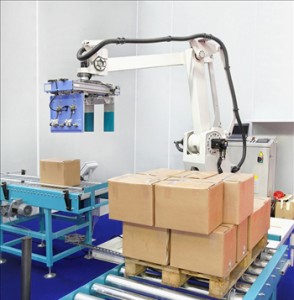Industrial logistics robot market set to top $31 billion
 Industrial logistics robot sales are growing fast, with a new study from Reportstock and WinterGreen Research estimating that the market will reach $31.3 billion by 2020. The report says that industrial logistics robot markets are becoming increasingly diversified, and that these robots will achieve significant growth in every sector.
Industrial logistics robot sales are growing fast, with a new study from Reportstock and WinterGreen Research estimating that the market will reach $31.3 billion by 2020. The report says that industrial logistics robot markets are becoming increasingly diversified, and that these robots will achieve significant growth in every sector.
As production of goods and services embrace automated processes, the industrial logistics robot is being used to adapt conveyor belts and end of line tasks and loading to a flexible systems approach. Because an automated process depends on the introduction of new logistics capability, the industrial logistics robot is taking over.
The industrial logistics robot industry is off to a fast start in 2014. Growth in industrial logistics robot sales is fueled by strong demand from manufacturing companies in all sectors for complete end to end automation of process.
The report on industrial logistics robot systems, entitled ‘Consideration of Robot Market Forecasts’ indicates that markets at $16 billion will reach $31.3 billion in industrial logistics robot sales by 2020. Growth comes as every industry achieves efficiency by automating logistics process robotically. Robots are unique because they can perform multiple steps without human intervention and they can adapt to different conditions and different types of devices to be manipulated. The sensors and the cameras in the robots make them flexible.
End-to-end process automation
Industrial logistics robot projects are ongoing worldwide with an emphasis on end-to-end process automation. The key to industrial logistics robot implementation is keeping costs down. Adapting existing tools, implementing commercial mechanisms, and loading and unloading pallets is emerging as the best way to build viable robots. High value projects are a target of robotic development. Industrial logistics robot systems are used to improve the delivery of consistent quality materials management and to implement efficiency in managing food production.
According to Susan Eustis, lead author of the WinterGreen Research team that prepared the study, “The opportunity to participate in industrial logistics robot markets is compelling. This new market is evolving as new automated process based on breakthroughs and innovation in technology is expressed in robotic platforms. Grippers, microprocessor technology, optics, cameras, nanotechnology, new materials, thin film batteries and sensors are among the technologies being put to use in innovative ways in robots. The ability to apply any technology from any company is phenomenal.
Industrial logistics robot technology is set to bring a new industrial revolution more important than anything seen before. An industrial logistics robot performs repetitive tasks efficiently, they do not eat, they do not make mistakes, they do not get tired, they do what they are told, and they work 24 hours per day 7 days a week. Manufacturing plants are frequently long aisles of nothing but robots, no human in sight.
Beyond the industrial logistics robot that simply repeats actions, more intelligent robots loaded with sensors are able to automate process using processors and cameras to control action. Use of microprocessors provides a measure of intelligent control over the activity of the robot based on input from the sensors and the cameras. Innovation allows maximizing investment in automated solutions. By allowing customers to retool product lines savings can be achieved. Current investment is protected. New systems are implemented without having to discard existing equipment and repurchase capital equipment.
Quality is a cornerstone of industrial logistics robot systems. Vendors have assembled teams of experienced engineers and technicians. The aim is to design, build, program, and maintain the highest-quality industrial logistics robot systems. The teams consistently work to find the right automation solution for every application. Most systems have some customisation. Longevity in the industry, along with employee combined years of experience, provide clients with the ability to create packaging and palletizing systems. Projects are managed with quality. Effective logistics solutions depend on expertise in end-of-line automation.
“The opportunity to participate in industrial logistics robot markets is compelling. This new market is evolving as new automated process based on breakthroughs and innovation in technology is expressed in robotic platforms.”
Material handling, warehousing, intralogistics, industrial cranes, lifts, cranes, storage and material flow are all aspects of industrial logistics robot market sectors. Production and warehouse logistics are evolving. Robot technology is based on platforms that leverage sensors, controllers, software modules, cameras, visualization, and locomotors deploying machines for control of all repeatable process. Industrialization is after all the repetition of some task to create process. Robots take this a step further to create automation of process with the ability to move the units.
Fanuc, Schaffer, Daifuku, Krones, Kuka, IMA Industries, Kawasaki, ABB, Yasakawa Motoman, Denso, Pro Mach, Gebo Cermex, MSK Covertech-Group, Panasonic, Coesia Group / Oystar, Toshiba, Siecort Epson, Seiko Epson, Fuji, Yamaha, BluePrint Automation BPA, Stabuli, Clevertech and Adept Technologies are some of the companies mentioned in this report.
Follow the link to read the full report on growth in industrial logistic robot markets.















